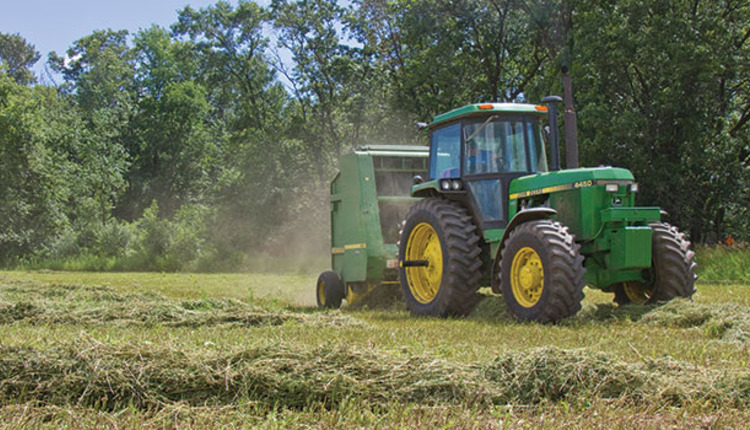
Down here in the Southern states it is already “go time” for most dairies and those putting up winter annuals. Our shop has been full the past few months doing winter inspections on our customers’ equipment and getting it ready to go. Though it may be hard to spend that extra money to replace a part that is not completely worn out yet, preventive maintenance can go a long way in impacting this year’s bottom line. A winter inspection of your equipment can show where your eventual downtime will come from. Most parts exhibit some type of wear and fatigue before they break.
For lots of our customers, the round baler is the center cog in their operation. If the baler goes down, field operations come to a standstill. Here is a list of some of the things that you can check on your baler before it spits out this year’s first bale.
Spend time with the PTO
The most logical place to start is at the front with the hitch. Make sure you look at all of the bolts or welds to be sure they are not loose or cracked. The baler hitch can take a lot of abuse.
The same is true for the power takeoff (PTO) shaft. Most balers these days come with a constant velocity (CV) shaft. It is critical to remove all of the shielding at least once a year to inspect the joint for wear and to make sure grease fittings are in place and that they accept grease. Also, the PTO shaft needs to be pulled completely out and greased. This is a must so that, during a turn, the shaft doesn’t bind and apply pressure to the main gearbox or the PTO on your tractor. Either of those are costly fixes when compared to greasing a PTO tube.
Most commercial balers have some sort of clutch on the PTO and depending on the make (for example, Walterschied, Weasler, Bondioli, or Comer) have instructions for inspecting and adjusting the clutch to make sure it slips when needed. Some companies even have videos on YouTube explaining the process.
The main T-shaped gearbox is often overlooked when doing annual maintenance, but spring is a good time to check the oil level and seals for leaks.
Baler manufacturers have similar ways of driving the baler, but each is just a little bit different. Chain and sprocket wear is critical to your baler’s performance. A loose chain or worn sprocket can cause your pickup to slip or main drive roller to jump. A lot of newer balers have idler sprockets that are tensioned by springs. In your baler’s operator’s manual, there will be a measurement so that each chain operates with the proper tension and can give under heavy load pressures. You may need to replace the chain or remove a link to achieve proper tension on the chain. Doing this now will lengthen the life of the sprockets.
The pickup mechanism is where your high-quality hay enters the baler. Check the tines and stripper bands for excessive wear or broken teeth. If equipped with a cam-type pickup, checking the cam roller bearing is a hard task, but lying on your shop floor is much more pleasant than lying on a hill of fire ants while working on a pickup in the summer heat.
Belts and bearings
If your baler uses belts, it is a good practice to pull out the belts and replace them every 10,000 bales or so. After belts stretch, they can’t apply the same pressure as when they were new and set at the correct factory measurements. Most balers now have different length belts, and if they are extremely worn you can always convert the long belts to the shorter ones.
A vast majority of balers sold these days are designed to apply net wrap. Most manufacturers use rubber rollers to feed the net to the bale. Inspecting the rubber roller is critical to make sure there are no rough places or cuts that could cause the net to grab and stick.
In the case of the rear-mounted net wrap balers, the net feeds under the tailgate. There is a plate on each belt to hold the net to the belts, and this is designed to be a wear item and needs to be checked. It’s often in the corners where the wear occurs and creates a good place for the net to hang up.
The bearings in the baling chamber seem to cause the most angst among round baler owners. Now is the time to check them, not when smoke is coming out the top of the chamber. Relieve the pressure on the belts in the chamber, so you can get in the baling chamber to check each of the rollers for any excessive movement or play.
I also encourage all of my customers to relieve the pressure on their belts during the off season, especially on older balers. This helps cut down the odds of a bearing developing a flat spot due to constant pressure over the winter months. When the chamber is empty and closed is usually the time belts and bearings are subject to the greatest amount of pressure.
Good luck this year, and safe baling.
This article appeared in the March 2017 issue of Hay & Forage Grower on page 8.
Not a subscriber? Click to get the print magazine.

